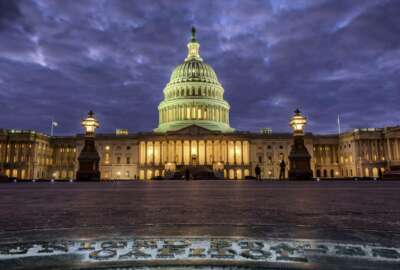
7 agencies expect to hire, but more will plan for staffing cuts under 2019 budget
The Trump administration is also suggesting policy changes to the federal hiring process, the requirements that govern the Senior Executive Service.
Subscribe to Federal Drive’s daily audio interviews on iTunes or PodcastOne.
A handful of agencies will add more to their staffing rolls in 2019, but many more departments will continue workforce reductions this year and into the next, according to the president’s most recent budget proposal.
But in a year when agency buyouts and staffing cuts plagued the government news cycle, all told, the total size of the federal workforce hasn’t changed that much over the last year. The Office of Management and Budget projected further, small increases to the workforce in 2018 and 2019.
“The 2019 budget details further proposed reductions in specific agencies,” the Trump administration wrote. “Estimated employment levels for 2019 are higher than the 2017 actual [full-time equivalent] levels and an increase from the 2018, all of which are slightly less than 2.1 million civilian employees.”
| Total Executive Branch Employment (Full-Time Equivalents) | ||||||||
| 2017 | 2018 (Estimate) | 2019 (Estimate) | ||||||
| All agencies, except USPS | 2,653,247 | 2,667,447 | 2,678,281 | |||||
(Data from president’s 2019 budget request)
But a deeper dive into agency workforce numbers shows that while some departments are bringing on more employees than they had in previous years, others aren’t filling vacant positions and are hiring far fewer workers.
The administration didn’t set specific full-time equivalent levels for each agency in 2019, and the numbers it did provide for 2018 and 2019 are merely estimates. Final workforce totals in 2018 for each agency will likely be different from the estimates OMB included in the president’s request, after lawmakers finish appropriations for fiscal 2018 later this month.
Here’s an agency-by-agency look at the total number of full-time equivalents, as outlined in the president’s budget proposal. Hover over each agency for workforce totals for 2016 and 2017, along with estimated projections for 2018 and 2019.
Some agencies, such as the departments of Agriculture, Interior, Housing and Urban Development, and Treasury, along with the Environmental Protection Agency already “conducted substantial decreases to the size of their workforce,” the White House said.
Those agencies, according to OMB’s estimates, will continue workforce cuts in 2019.
For example, the Trump administration is proposing a nearly 25 percent cut — a reduction of 3,800 employees — to EPA’s workforce for next year.
USDA, which has already begun and will likely continue a reorganization of several offices and subcomponents, would lose 7,800 employees in 2019, a cut of 8.8 percent.
And the Interior Department, which received authority in the president’s budget to begin its plan of organizing and managing the agency based on 13 broad regions across the country, would lose 4,600 full-time equivalents, the administration said.
Seven agencies, in fact, are expected to boost hiring between 2018 and 2019, including the departments of Commerce, Homeland Security and Veterans Affairs.
The president is authorizing an additional 7,000 full-time equivalents for VA. About 600 of those new hires would help the Veterans Benefits Administration work through a new appeals process.
The administration also projected a 7.2 percent boost in hiring for DHS, or about 13,000 additional full-time equivalents.
The Commerce Department may be on track for a 21.3 percent increase in hiring. Nearly all of the department’s additional hiring would come from adding nearly 9,000 new employees to work on the 2020 Census.
Yet other bureaus in Commerce would see staffing cuts. The administration proposed a complete cut to the Economic Development Administration, for example, and the National Institute of Standards and Technology would lose about 300 employees.
Some agencies are losing personnel as the president continues to shift priorities away from those of the previous administration. But the current workforce numbers and future projections also show another shift: agencies are beginning to think how they re-skill current employees for different jobs that need new skills.
“Agencies will continue to examine their workforces to determine what jobs they need to accomplish their mission, taking into account the impact of technological investments that automate transactional processes, artificial intelligence that can streamline the byzantine compliance and regulatory processes, online and telephone chat-bots to improve customer service and other such tools that may reduce agency personnel needs,” the White House wrote in the 2019 request.
But the budget also includes a grab-bag of other workforce priorities that many good government and federal employee groups have been discussing throughout the past several years.
For example, shortening the current, 14-step hiring process appears to be a top priority for the Trump administration. The current hiring timeline isn’t conducive to recruiting a young talent, who may have more of an interest in spending just a few years working in government, rather than a 30-year career.
“The effectiveness of our government will continue to be limited so long as we can neither recruit new, top talent, nor adequately train and retain the talent we have already hired,” Senior Executives Association President Bill Valdez said Monday of the 2019 budget request. “Our government must better position itself to modernize and compete in the global labor market. And a slew of both administrative and statutory reforms will be necessary to refresh our approach to maintaining — and continuing to develop and grow — a world-class, non-partisan government workforce.”
Latest Workforce News
The administration is also interested in reexamining the Senior Executive Service. It’s continuing to review current policies governing the SES and is considering how it can create “a more robust and effective SES succession pipeline, which could include more recruitment outreach into the private sector,” the White House said.
As agencies continue their efforts to reorganize and shed low-value work in favor of high-value activities, the administration said it’s focused on reskilling the existing federal workforce.
“Employees who perform transactional work that is phased out can shift to working more directly with customers or on more complex and strategic issues,” the budget reads. “Current employees can shift from legacy positions into emerging fields in which the government faces shortages, including data analysis, cybersecurity and other IT disciplines.”
Though some federal employee groups applauded the workforce priorities included in the president’s 2019 request, many also slammed the administration’s proposals to freeze pay and cut retirement benefits.
Max Stier, president and CEO of the Partnership for Public Service, applauded the president’s call for an update to a 40-year-old civil service law and 70-year-old pay structure.
“We must continue doing all we can to ensure that government is able to recruit and retain mission-critical talent,” he said in a statement. “However, the administration’s proposal for a government-wide pay freeze in fiscal year 2019 could do just the opposite.”
The Federal Managers Association had stronger words, describing the president’s pay freeze proposal as “callous and unfair.” It questioned why the administration included a 2.6 percent bump for members of the military but no raise for civilian employees.
“They deserve to be recognized and compensated fairly, and we are demoralized by the lack of pay parity,” FMA President Renee Johnson said. “While we note the president has proposed an inter-agency fund in an effort to advance pay-for-performance, until we see greater detail FMA will continue to call for a judicious pay raise for federal employees.”
Copyright © 2024 Federal News Network. All rights reserved. This website is not intended for users located within the European Economic Area.
Nicole Ogrysko is a reporter for Federal News Network focusing on the federal workforce and federal pay and benefits.
Follow @nogryskoWFED
Related Stories






